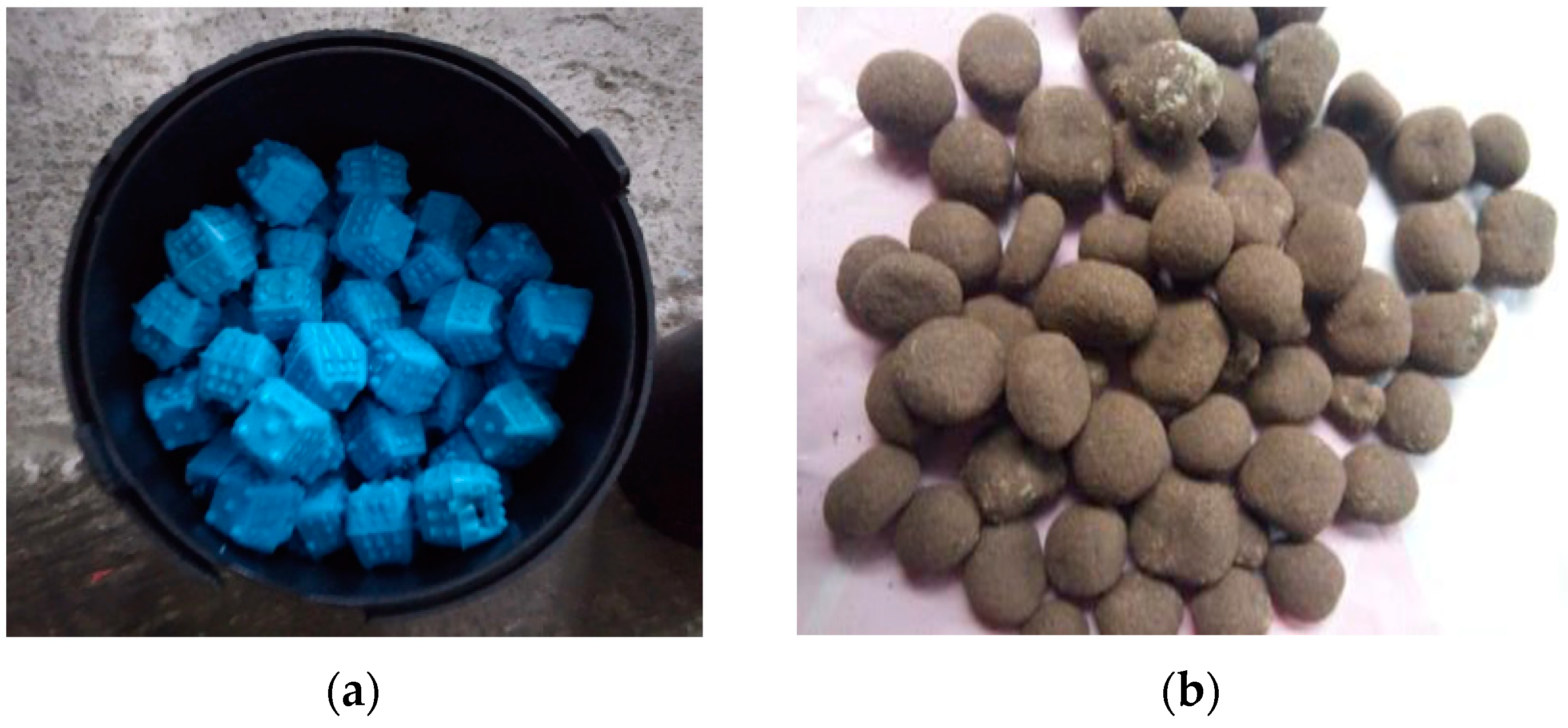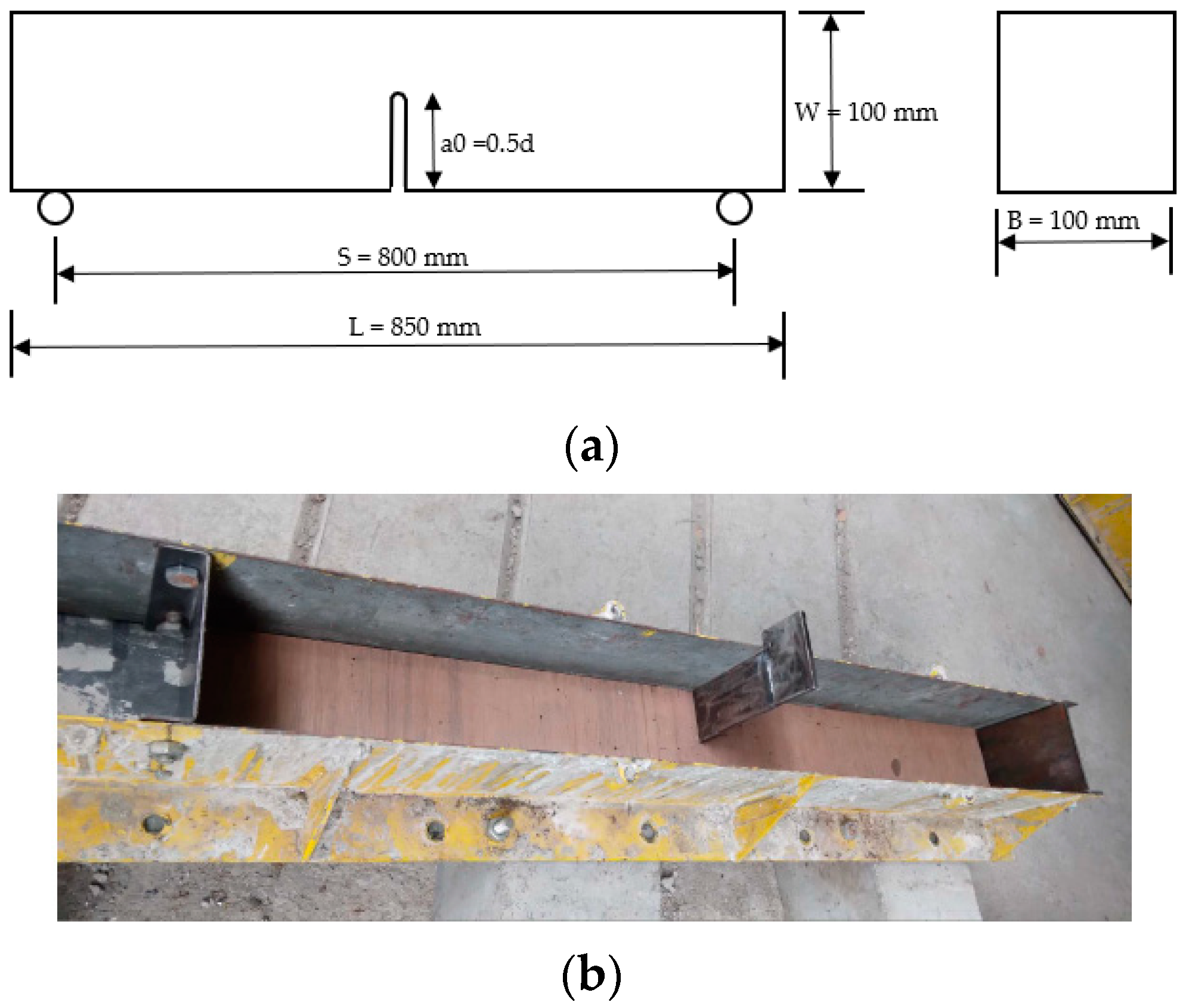Method for Determining Fracture Energy of a Polypropylene Coarse Lightweight Aggregate Concrete Beam Using Digital Image Correlation †
Abstract
1. Introduction
2. Proposed Method
2.1. Work of Fracture Method (WFM)
2.2. Size Effect Method (SEM)
2.3. Digital Image Correlation (DIC)
3. Experimental Program
3.1. Materials
3.2. Mix Design and Test Specimen Preparation
3.3. Test Procedure
4. Analysis Mechanism
4.1. Mechanical Properties
4.2. Analysis of Fracture Parameters based on SEM
4.3. DIC Analysis of Fracture Behavior
5. Conclusions
Author Contributions
Funding
Institutional Review Board Statement
Informed Consent Statement
Data Availability Statement
Conflicts of Interest
References
- Kulbhushan, K.; Kumar, S.; Chaudhary, R.; Ahmad, S.; Gupta, S.; Chaurasia, R. A Contextual Analysis of the advantages by using lightweight concrete blocks as substitution of bricks. Int. Res. J. Eng. Technol. 2018, 5, 6. [Google Scholar]
- Poonyakan, A.; Rachakornkij, M.; Wecharatana, M.; Smittakorn, W. Potential use of plastic wastes for low thermal conductivity concrete. Materials 2018, 11, 1938. [Google Scholar] [CrossRef] [PubMed]
- Adnan, H.M.; Dawood, A.O. Strength behavior of reinforced concrete beam using re-cycle of PET wastes as synthetic fibers. Case Stud. Constr. Mater. 2020, 13, e00367. [Google Scholar] [CrossRef]
- Mohammed, A.A.; Rahim, A.A.F. Experimental behavior and analysis of high strength concrete beams reinforced with PET waste fiber. Constr. Build. Mater. 2020, 244, 118350. [Google Scholar] [CrossRef]
- Noori, A.Q.N.; Numan, H.A. Behavior of sustainable reinforced concrete building containing waste plastic and fibers. In IOP Conference Series: Materials Science and Engineering; IOP Publishing: Bristol, UK, 2020; Volume 870, p. 012094. [Google Scholar]
- Akbari, M.; Tahamtan, M.H.N.; Fallah-Valukolaee, S.; Herozi, M.R.Z.; Shirvani, M.A. Investigating fracture characteristics and ductility of lightweight concrete containing crumb rubber by means of WFM and SEM methods. Theor. Appl. Fract. Mech. 2022, 117, 103148. [Google Scholar] [CrossRef]
- Khalilpour, S.; BaniAsad, E.; Dehestani, M. A review on concrete fracture energy and effective parameters. Cem. Concr. Res. 2019, 120, 294–321. [Google Scholar] [CrossRef]
- Falliano, D.; De Domenico, D.; Sciarrone, A.; Ricciardi, G.; Restuccia, L.; Ferro, G.; Tulliani, J.-M.; Gugliandolo, E. Influence of biochar additions on the fracture behavior of foamed concrete. Frat. Integrità Strutt. 2020, 14, 189–198. [Google Scholar] [CrossRef]
- Li, J.; Wan, C.; Zhang, X.; Niu, J. Fracture property of polypropylene fibre-reinforced lightweight concrete at high temperatures. Mag. Concr. Res. 2020, 72, 1147–1154. [Google Scholar] [CrossRef]
- Yang, J.; Song, C.; Wang, Q. Comparative analysis of the effects of aggregates and fibres on the fracture performance of lightweight aggregate concrete based on types I and II fracture test methods. Theor. Appl. Fract. Mech. 2022, 117, 103202. [Google Scholar] [CrossRef]
- Afzali-Naniz, O.; Mazloom, M.; Karamloo, M. Effect of nano and micro SiO2 on brittleness and fracture parameters of self-compacting lightweight concrete. Constr. Build. Mater. 2021, 299, 124354. [Google Scholar] [CrossRef]
- Mehrab, A.H.; Esfahani, M.R. Experimental Study on Size Effect and Fracture Properties of Polypropylene Fiber Reinforced Lightweight Aggregate Concrete. Period. Polytech. Civ. Eng. 2022, 66, 1278–1293. [Google Scholar]
- Dabbaghi, F.; Fallahnejad, H.; Nasrollahpour, S.; Dehestani, M.; Yousefpour, H. Evaluation of fracture energy, toughness, brittleness, and fracture process zone properties for lightweight concrete exposed to high temperatures. Theor. Appl. Fract. Mech. 2021, 116, 103088. [Google Scholar] [CrossRef]
- Karamloo, M.; Afzali-Naniz, O.; Doostmohamadi, A. Impact of using different amounts of polyolefin macro fibers on fracture behavior, size effect, and mechanical properties of self-compacting lightweight concrete. Constr. Build. Mater. 2020, 250, 118856. [Google Scholar] [CrossRef]
- Nikbin, I.M.; Farshamizadeh, M.; Jafarzadeh, G.A.; Shamsi, S. Fracture parameters assessment of lightweight concrete containing waste polyethylene terephthalate by means of SEM and BEM methods. Theor. Appl. Fract. Mech. 2020, 107, 102518. [Google Scholar] [CrossRef]
- Parmadi, B.J.; Handika, N.; Sutanto, D.; Sentosa, B.O. Recycled aggregate concrete beam: Experimental study using digital image correlation (DIC) and numerical study using multi-fibre Timoshenko beam element in CAST3M. In AIP Conference Proceedings; AIP Publishing: Damansara, Malaysia, 2023; Volume 2847. [Google Scholar]
- Ernawan, E.; Sjah, J.; Handika, N.; Astutiningsih, S.; Vincens, E. Mechanical Properties of Concrete Containing Ferronickel Slag as Fine Aggregate Substitute Using Digital Image Correlation Analysis. Buildings 2023, 13, 1463. [Google Scholar] [CrossRef]
- Deltanto, A.D.; Handika, N.; Sentosa, B.O.B. Response of load-displacement on cubical sample of Oil-Palm shell with fly ash concrete using digital image correlation system. In AIP Conference Proceedings; AIP Publishing: Depok, Indonesia, 2021; Volume 2376. [Google Scholar]
- Hongsen, K.; Melhan, M.; Handika, N.; Sentosa, B.O.B. Parameterization of Oil Palm Shell Concrete on Numerical Damage Model Based on Laboratory Experiment using Digital Image Correlation. J. Phys. Conf. Ser. 2021, 1858, 012029. [Google Scholar] [CrossRef]
- Sudarsanan, N.; Zeng, Z.A.; Kim, Y.R. Laboratory investigation into the crack propagation mechanism of geosynthetic reinforced asphalt concrete using digital image correlation technique. Int. J. Pavement Eng. 2023, 24, 2251079. [Google Scholar] [CrossRef]
- Bu, J.; Wu, X.; Xu, H.; Chen, X. The rate effect on fracture mechanics of dam concrete based on DIC and AE techniques. J. Strain Anal. Eng. Des. 2022, 57, 496–510. [Google Scholar] [CrossRef]
- Ning, Y.; Ye, L.; Bai, L.; Xie, C.; Xu, H. Experimental Study on Fracture Properties of Hydraulic Concrete with Different Crack-Depth Ratios Based on Acoustic Emission and DIC Techniques. Adv. Mater. Sci. Eng. 2022, 2022, 8771674. [Google Scholar] [CrossRef]
- Recommendation, R.D. Determination of the fracture energy of mortar and concrete by means of three-point bend tests on notched beames. Mater. Struct. 1985, 18, 285–290. [Google Scholar]
- Hillerborg, A.; Modéer, M.; Petersson, P.-E. Analysis of crack formation and crack growth in concrete by means of fracture mechanics and finite elements. Cem. Concr. Res. 1976, 6, 773–781. [Google Scholar] [CrossRef]
- D’Essai, M.; Mé, T.; De La Rilem, P. Size-effect method for determining fracture energy and process zone size of concrete. Mater. Struct. 1990, 1, 7. [Google Scholar]
- Bazant, Y.; Kazemi, M. Determination of fracture energy, process zone longth and brittleness number from size effect, with application to rock and conerete. Int. J. Fract. 1990, 44, 111–131. [Google Scholar] [CrossRef]
- Blikharskyy, Y.; Kopiika, N.; Khmil, R.; Blikharskyy, Z. Digital Image Correlation Pattern for Concrete Characteristics—Optimal Speckle. In International Conference Current Issues of Civil and Environmental Engineering Lviv-Košice–Rzeszów; Springer: Berlin/Heidelberg, Germany, 2013; pp. 22–31. [Google Scholar]
- Pamudji, G.; Purnomo, H.; Katili, I.; Imran, I. The use of plastics waste as coarse aggregates for moderate strength concrete. In Proceedings of the 6th Civil Engineering Conference in Asia Region: Embracing the Future through Sustainability, Hotel Borobudur, Jakarta, 20–22 August 2013; pp. 602–978. [Google Scholar]
- Perdani. Kajian Numerik Pull-Out Beton Ringan Beragregat Polipropilen Menggunakan Variasi Diameter Tulangan Dengan Fokus Eksperimen Pada Tes Tekan Silinder. Undergraduate Thesis, Universitas Indonesia, Depok, Indonesia, 2017.


| Target Strength Class | w/c Ratio | Cement | Sand | PP Aggregate | Water | SP |
|---|---|---|---|---|---|---|
| 17–18.9 MPa | 0.29 | 1 | 2 | 2.6 | 0.85 | 0.60% |
| 19–20.9 MPa | 0.28 | 1 | 2 | 2 | 081 | 0.70% |
| >21 MPa | 0.286 | 1 | 2 | 1.8 | 0.9 | 0.80% |
| Specimens | Standard | Number of Repetitions Per Mix | Achievable Parameter |
|---|---|---|---|
| 150 × 300 mm3 cylindrical specimen | ASTM C496 | three | Modulus of elasticity |
| three | Direct tensile strength | ||
| three | Poisson’s Ratio | ||
| 100 × 200 mm3 cylindrical specimen | ASTM C39 | three | Compressive strength |
| 100 × 100 × 840 mm3 beam specimen | RILEM FMC-50 | three | Fracture toughness (WFM) |
| RILEM FMT-89 | three | Fracture toughness (SEM) | |
| 75 × 75 × 630 mm3 beam specimen | RILEM FMT-89 | three | Fracture toughness (SEM) |
| 125 × 125 × 1050 mm3 beam specimen | RILEM FMT-89 | three | Fracture toughness (SEM) |
Disclaimer/Publisher’s Note: The statements, opinions and data contained in all publications are solely those of the individual author(s) and contributor(s) and not of MDPI and/or the editor(s). MDPI and/or the editor(s) disclaim responsibility for any injury to people or property resulting from any ideas, methods, instructions or products referred to in the content. |
© 2024 by the authors. Licensee MDPI, Basel, Switzerland. This article is an open access article distributed under the terms and conditions of the Creative Commons Attribution (CC BY) license (https://creativecommons.org/licenses/by/4.0/).
Share and Cite
Musalamah, S.; Purnomo, H.; Handika, N. Method for Determining Fracture Energy of a Polypropylene Coarse Lightweight Aggregate Concrete Beam Using Digital Image Correlation. Eng. Proc. 2024, 63, 19. https://doi.org/10.3390/engproc2024063019
Musalamah S, Purnomo H, Handika N. Method for Determining Fracture Energy of a Polypropylene Coarse Lightweight Aggregate Concrete Beam Using Digital Image Correlation. Engineering Proceedings. 2024; 63(1):19. https://doi.org/10.3390/engproc2024063019
Chicago/Turabian StyleMusalamah, Sittati, Heru Purnomo, and Nuraziz Handika. 2024. "Method for Determining Fracture Energy of a Polypropylene Coarse Lightweight Aggregate Concrete Beam Using Digital Image Correlation" Engineering Proceedings 63, no. 1: 19. https://doi.org/10.3390/engproc2024063019
APA StyleMusalamah, S., Purnomo, H., & Handika, N. (2024). Method for Determining Fracture Energy of a Polypropylene Coarse Lightweight Aggregate Concrete Beam Using Digital Image Correlation. Engineering Proceedings, 63(1), 19. https://doi.org/10.3390/engproc2024063019






